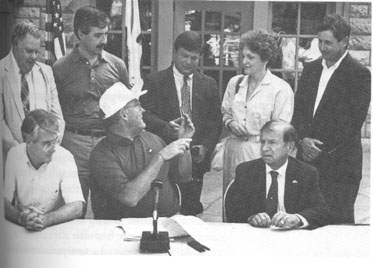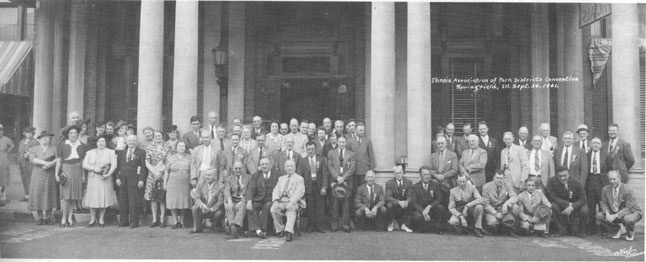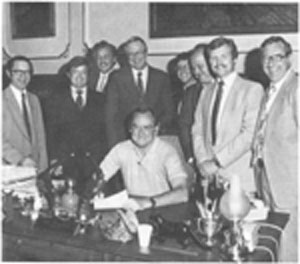
SPECIAL FOCUS
IAPD Makes History
Celebrating 70 years of service in 1998
BY DR. TED FLICKINGER, CLP
| Then governor James R. Thompson gins IAPD executive director Ted Flickinger the pen he used to sign into law on October 5, 1989, permanent funding for the Open Space Land Aquisition and Development program and the Illinois Bikeway Paths. |
|
From a small start of 16 park districts in May of 1928, the Illinois Association of Park Districts (IAPD) has grown to 319 member park districts, forest preserves, conservation and recreation agencies. LAPD's first year budget of $925 and one volunteer staff member has increased to nine full-time staff and an operating budget of more than $ 1 million.
LAPD's growth over the past 69 years is due to the tremendous commitment of the elected board members and directors from these member agencies. As a united voice for parks, recreation and natural resources, we've come a long way in securing public open space and improving the quality of life for citizens in Illinois.
Grassroots activism has always driven IAPD, even from its earliest beginnings. The first efforts to create a statewide association of Illinois park district officials took the form of a letter-writing campaign to park district officials on March 9, 1928, by A. D. McLarty, then executive secretary of the Illinois Municipal League in Springfield. The letters proposed the idea of a separate association or a park district section of the Municipal League, and the replies indicated widespread interest.
Dr. Joseph Cullen Blair, then head of the Department of Horticulture at the University of Illinois and president of the Urbana Park District, shared the dream of forming a statewide group and was elected as the LAPD's first president. A.D. McLarty was elected first secretary and served continuously as such until July 1, 1943, when he resigned to enter the U.S. Navy.
In May 1951, Governor Adlai Stevenson signed the Park Law Codification Bill. Subsequently, Marjorie M. Dickinson was hired in June 1953 as the part time secretary for the Illinois Association of Park Districts (IAPD) and editor of its publication Illinois Parks. Several years later, Dickinson was designated as executive vice president of IAPD, a capacity she served until December 1966. The executive vice presidents that followed included Arthur L. Schultz (1967-1971), a one-time assistant to the superinten
September / October 1997 / 39
SPECIAL FOCUS
Today IAPD continues the forward momentum started by 16 visionary park districts nearly 70 years ago.
dent of the Chicago Park District, and Eugene Berghoff (1971-1979), a circuit clerk for Madison County, Ill., and a longtime public employee of the state.
Robert Artz was chosen to become the associations first executive director in January 1979. A recreation professional with more than 20 years of experience in park administration. Bob Artz's influence and leadership of IAPD was never fully realized; he died in the tragic Chicago DC-10 crash on May 25, 1979.
After a lengthy national search, Dr. Theodore B. Flickinger—a former park district director, university professor, and director of the National Recreation and Park Association's Midwest region—became lAPD's executive director in March of 1980. Flickinger, a certified leisure professional and certified association manager, remains at the helm today. During the past 17 years of his leadership, LAPD's services have expanded along with the growing numbers and needs of its members.
As expressed in the first constitution of the association, the purpose of IAPD was: " to serve as a mutual agency for cooperation of park districts of the state in the practical study and in the opportunity for discussion of park district problems; park policy and administration; to gather and circulate information and experience on park district affairs; to secure beneficial and oppose legislation injurious to park districts." With few amendments, the association is still guided by this initial document. "Park district" and "park board" as used in the constitution and the bylaws mean any incorporated park district, forest preserve district, conservation district or park and recreation agency in Illinois and members of their governing bodies. IAPD is also proud to represent more than 30 city park and recreation agencies.
In the course of its history, the IAPD has had 61 presidents. The board of directors is comprised of 19 board members representing districts from all regions of the state.
With the exception of the 1946 and 1948 meetings, IAPD held its own annual conference from 1928 to 1959. The first of these was held in Joliet in September of 1928 and was attended by 38 representatives from the 16 "founding" park districts. In 1946, 1948 and since 1960, the IAPD and the Illinois Park and Recreation Society, (now the Illinois Park and Recreation Association or IPRA), have held a joint annual conference. Today these combined conferences provide more than 200 educational programs, display 270 commercial exhibitors, and are attended by more than 3,000 board members and professionals in the field.
At the 1969 annual conference, the first joint committee of IAPD and the Illinois Park and Recreation Society met. The committee was adopted to develop cooperative efforts between these organizations. This committee, now referred to as the Coordinating Council, continues to function.
Collection and distribution of information has always been an important and valuable service of the association. Initially, IAPD had its own magazine, Illinois Parks, but since a joint resolution with IPRA in November 1970 it was renamed Illinois Parks & Recreation. Ted Flickinger became the managing editor of this award-winning magazine in 1982. IAPD has subsequently developed new joint publications, produced at the association headquarters in Springfield: the joint newsletter, Leisure Review, and the IAPD/IPRA Membership Directory and Buyers' Guide, the "yellow pages" for the field.
Legislative advocacy, too, has been a top priority.
Many legislative measures that benefit park districts
and forest preserves have been passed because of the
effective grassroots lobbying of IAPD members.
IAPD legislative milestones include the following:
• 1941——park districts received authorization to levy
the .05% recreation tax
• 1951—Illinois laws relating to park districts are
codified
• 1961—Sections 5-2(a) and 5-2(b) were added to
the Park District Code to permit the functions of
a municipal recreation commission to be merged
with and assumed by a park district
• 1973—authorized to levy a tax for the organization and maintenance of a park police system
• 1976—added article 11.2 authorizing creation of
a working cash fund and the levy of .025%
• 1982—doubled the museum tax
• 1987—doubled SRA tax and removed the
referendum requirement
• 1986—established OSLAD funding
• 1989—enacted Bicycle Path Grants program
• 1995—Conservation 2000 signed into law
• 1995—Senate Bill 368 passed, restoring bonding
authority to agencies under the tax cap
In the last two decades, IAPD has experienced
tremendous growth. Its wide array of member
services and programs include technical assistance
and education, legislative advocacy programs and
training, public relations, legal services, publications,
management and financial services.
In the 1980s, IAPD spearheaded the establishment of the Open Space Land Acquisition and Development (OSLAD) program and presented the first Governor's Conference on the Economic Significance of Recreation in the nation. The association purchased its own building, strategically located across the street from the state capitol in Springfield and introduced a new member service,
40 / Illinois Parks and Recreation
IAPD MAKES HISTORY

the Illinois Park District Liquid Asset Fund (IPDLAF), a cost-effective investment pool for members. State Fair activity featured "Fitness Is Leading the Way" and "Local Officials Day." Then came the Illinois football games with legislative tailgates and the marketing program "Life. Be In It."
The 1990s are marked by many achievements including the publication of a white paper report on the "Economic Benefits of Illinois Park District Leisure Services," which is the forerunner of a current nationwide movement promoting the benefits of park districts and forest preserves. IAPD established the Director Search Service and the Illinois Park Association Risk Services (IPARKS) program to provide a group self-insurance pool. Public relations activities were stepped up with "Take Time for Fun!" and "The Benefits Are Endless" campaigns, "Walk Illinois" and "Park District Conservation Day" at the Illinois State Fair.
Throughout IAPD history, partnerships have been key to our successes. Productive relationships with leaders in state government are continually fostered, including the Governor's Office and the Office of the Attorney General, a co-sponsor of two recent summits for youth at risk. IAPD has partnered with nearly all state departments, including Natural Resources, Aging, Commerce and Community Affairs, Transportation, and Public Health. Other pinners include private sector companies, nonprofit organizations, associations representing school boards and professionals, and others with a vested interest in the field.
Today IAPD continues the forward momentum started by 16 visionary park districts nearly 70 years ago. Our history is rich and productive. We have a proud past and a promising future.

|
|
DR.TED FLICKINGER, CLP is the executive director of the Illinois Association of Park Districts
Top: Illinois Association of Pork Districts annual convention in Springfield held September 24, 1941. Left: Governor James R. Thompson signs yet another bill that benefits pork districts and forest preserves in1980. Right: During its 60th anniversary year in 1988, IAPD established its new headquarters at 21 1 E. Monroe Street in Springfield, located across the street from the State Capitol. The line drawing Is by artist William E. Crook.
September / October 1997/ 41